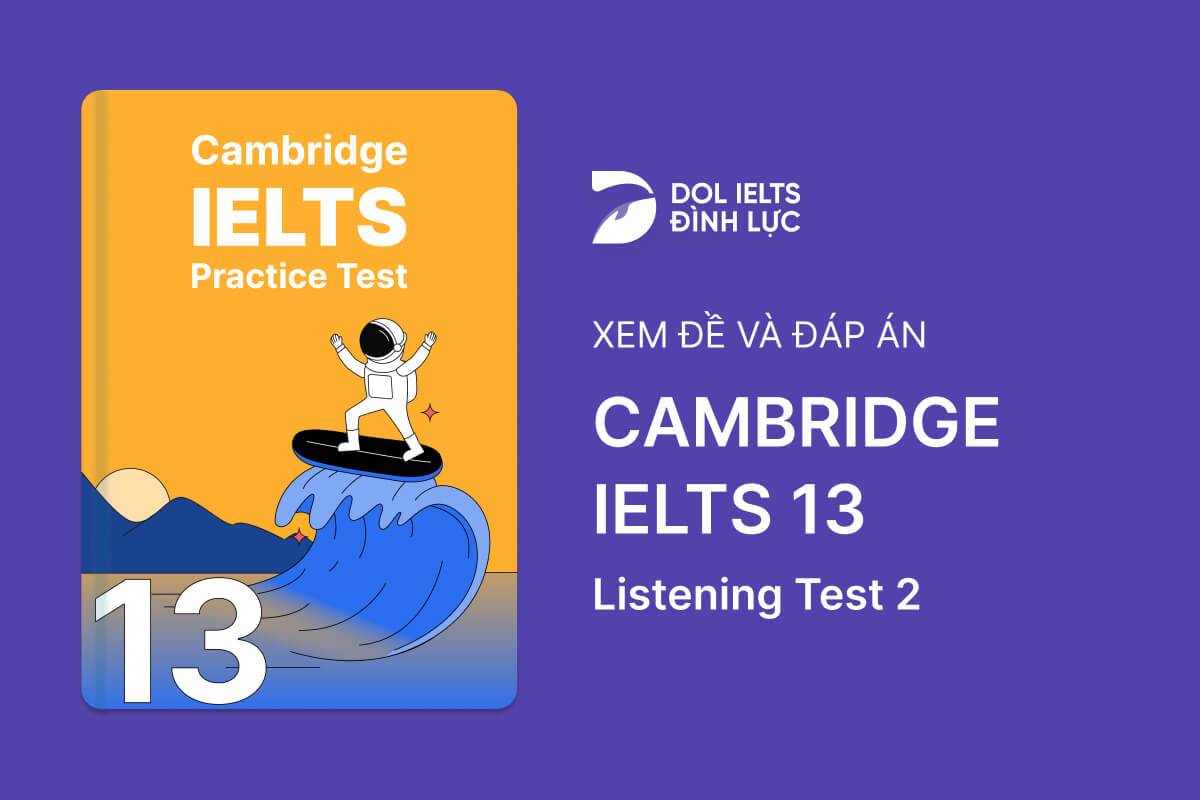Cambridge IELTS 13 - Listening Test 2 With Practice Test, Answers And Explanation
Luyện tập đề IELTS Online Test Cambridge IELTS 13 - Listening Test 2 được lấy từ cuốn sách Cambridge IELTS 13 với trải nghiệm thi IELTS trên máy và giải thích đáp án chi tiết bằng Linearthinking, kèm answer key và list từ vựng IELTS cần học trong bài đọc.
Section
👂️ Bài nghe section 1
Full membership costs $260; this covers cycling and
all over Australia1
Recreational membership costs $108
Cost of membership includes the club fee and
2
The club kit is made by a company called
3
Chance to improve cycling skills and fitness
Level B: speed about
kilometres.4
Weekly sessions
Tuesdays at 5.30 am, meet at the
5Thursdays at 5.30 am, meet at the entrance to the
6
Rides are about an hour and half
Members often have
together afterwards7
There is not always a
with the group on these rides8
Check and print the
on the website beforehand9
Bikes must have
10
❓ Tapescript section 1
🔥 Đáp án & giải thích section 1
Giải thích chi tiết
 Xác định loại từ cần điền là noun và đi song song với từ cycling
Xác định loại từ cần điền là noun và đi song song với từ cycling
 Sau khi nghe thấy “Full membership”
Sau khi nghe thấy “Full membership”
>> Đáp án chuẩn bị vào
 Tiếp tục thấy nói đến giá là 260 dollar và cover not just ordinary cycling but also for races ...
Tiếp tục thấy nói đến giá là 260 dollar và cover not just ordinary cycling but also for races ...
>> Mình thấy có cấu trúc song song not only ... but also
Section
👂️ Bài nghe section 2
❓ Tapescript section 2
🔥 Đáp án & giải thích section 2
Giải thích chi tiết
 Sau khi nghe “The idea is that we allow staff to give up some of their work time to help on various charity projects ” là biết các câu tiếp theo sẽ chứa thông tin liên quan đến câu trả lời
Sau khi nghe “The idea is that we allow staff to give up some of their work time to help on various charity projects ” là biết các câu tiếp theo sẽ chứa thông tin liên quan đến câu trả lời
 Hai câu tiếp theo là câu dẫn đến câu trả lời, tuy nhiên sau câu thứ 2, mình đã rút ra được ý: "doesn't necessarily involve a huge time commitment"
Hai câu tiếp theo là câu dẫn đến câu trả lời, tuy nhiên sau câu thứ 2, mình đã rút ra được ý: "doesn't necessarily involve a huge time commitment"
>> Câu trả lời đang chuẩn bị vào
 Sau đó nghe “The company will pay for eight hours of your time.”
Sau đó nghe “The company will pay for eight hours of your time.”
>> Mình thấy có nhắc đến 8 hours >> Đến câu sau “That can be used over one or two days all at once, or spread over several months throughout the year”
>> That trong câu chính là thay thế cho 8 hours, mình thấy họ nhắc đến 1,2 ngày và vài tháng nhưng cuối cùng lại có cụm "throughout the year”
>> 8 giờ này sẽ được dùng trong cả 1 năm >> đáp án đúng là C 
 Một số bạn nghe one or two days sẽ có thể chọn B
Một số bạn nghe one or two days sẽ có thể chọn B
Section
👂️ Bài nghe section 3
❓ Tapescript section 3
🔥 Đáp án & giải thích section 3
Giải thích chi tiết
 Sau khi nghe “ And I'm really struggling” = difficulty biết đáp án chuẩn bị vào
Sau khi nghe “ And I'm really struggling” = difficulty biết đáp án chuẩn bị vào
 Tiếp mình nghe được Russ chọn topic vì không biết nhiều về lĩnh vực mày và muốn học thêm, nhiều bạn sẽ chọn đáp án A
Tiếp mình nghe được Russ chọn topic vì không biết nhiều về lĩnh vực mày và muốn học thêm, nhiều bạn sẽ chọn đáp án A
>> Tuy nhiên nếu nghe hết sẽ thấy vế sau “now I’ve read so much about it, in a way there's too much to say “
>> Giờ Russ đã đọc và biết nhiều về topic này
>> Loại đáp án A
Section
👂️ Bài nghe section 4
The ability to recall details e.g. the time and
of past events31
Different to semantic memory- the ability to remember general information about the
which does not involve recalling32 information.33
Involves receiving and processing information
The more
given to an event the more successfully it can be encoded34
To remember a
it is useful to have a strategy for encoding such information35
How memories are strengthened and stored
Most effective when memories can be added to a
36
The
of retrieval affects the strength of memories37
Memory retrieval often depends on using a prompt e.g. the
of an object near to the place where you left your car38
These affect people with a wide range of medical conditions
Games which stimulate the
have been found to help people with schizophrenia39
Children with autism may have difficulty forming episodic memories – possibly because their concept of the
may be absent40
Memory training may help autistic children to develop social skills
❓ Tapescript section 4
🔥 Đáp án & giải thích section 4
Giải thích chi tiết
 Xác định loại từ cần điền là noun đi song song với the time và thuộc về past events
Xác định loại từ cần điền là noun đi song song với the time và thuộc về past events
 Sau khi nghe câu đầu tiên thấy " event from the past"
Sau khi nghe câu đầu tiên thấy " event from the past"
>> Đáp án đang chuẩn bị vào
 Sau đó nghe được Episodic memories include details về những events này như là khi sự kiện xảy ra "when an event happened"= the time và những thông tin khác such as location
Sau đó nghe được Episodic memories include details về những events này như là khi sự kiện xảy ra "when an event happened"= the time và những thông tin khác such as location
>> Từ location đi song song với the time trong ví dụ


